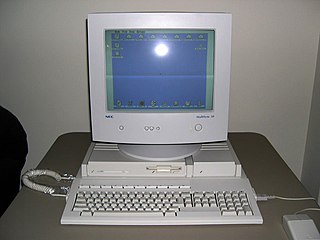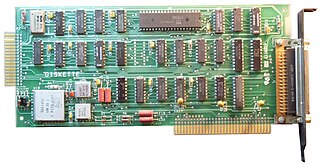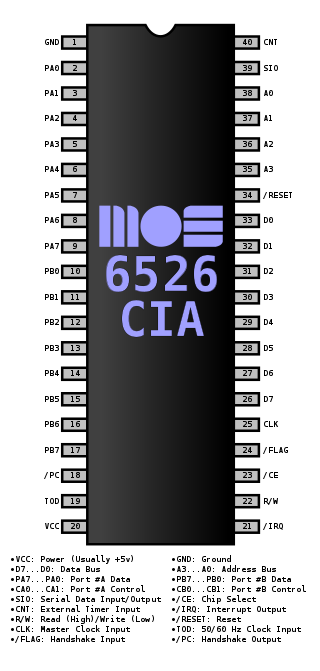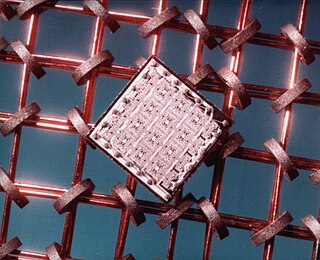
The Commodore 64, also known as the C64, is an 8-bit home computer introduced in January 1982 by Commodore International. It has been listed in the Guinness World Records as the highest-selling single computer model of all time, with independent estimates placing the number sold between 12.5 and 17 million units. Volume production started in early 1982, marketing in August for US$595. Preceded by the VIC-20 and Commodore PET, the C64 took its name from its 64 kilobytes(65,536 bytes) of RAM. With support for multicolor sprites and a custom chip for waveform generation, the C64 could create superior visuals and audio compared to systems without such custom hardware.

An integrated circuit (IC), also known as a microchip, computer chip, or simply chip, is a small electronic device made up of multiple interconnected electronic components such as transistors, resistors, and capacitors. These components are etched onto a small piece of semiconductor material, usually silicon. Integrated circuits are used in a wide range of electronic devices, including computers, smartphones, and televisions, to perform various functions such as processing and storing information. They have greatly impacted the field of electronics by enabling device miniaturization and enhanced functionality.

The MOS Technology 6502 is an 8-bit microprocessor that was designed by a small team led by Chuck Peddle for MOS Technology. The design team had formerly worked at Motorola on the Motorola 6800 project; the 6502 is essentially a simplified, less expensive and faster version of that design.

The MOS Technology 6510 is an 8-bit microprocessor designed by MOS Technology. It is a modified form of the very successful 6502. The 6510 is widely used in the Commodore 64 (C64) home computer and its variants.

The 6800 is an 8-bit microprocessor designed and first manufactured by Motorola in 1974. The MC6800 microprocessor was part of the M6800 Microcomputer System that also included serial and parallel interface ICs, RAM, ROM and other support chips. A significant design feature was that the M6800 family of ICs required only a single five-volt power supply at a time when most other microprocessors required three voltages. The M6800 Microcomputer System was announced in March 1974 and was in full production by the end of that year.

MOS Technology, Inc. ("MOS" being short for Metal Oxide Semiconductor), later known as CSG (Commodore Semiconductor Group) and GMT Microelectronics, was a semiconductor design and fabrication company based in Audubon, Pennsylvania. It is most famous for its 6502 microprocessor and various designs for Commodore International's range of home computers.

The Intel 8085 ("eighty-eighty-five") is an 8-bit microprocessor produced by Intel and introduced in March 1976. It is the last 8-bit microprocessor developed by Intel.

The KIM-1, short for Keyboard Input Monitor, is a small 6502-based single-board computer developed and produced by MOS Technology, Inc. and launched in 1976. It was very successful in that period, due to its low price and easy-access expandability.

The Atari Falcon030, released in 1992, is the final personal computer from Atari Corporation. A high-end model of the Atari ST line, the machine is based on a Motorola 68030 CPU and a Motorola 56001 digital signal processor, which distinguishes it from most other microcomputers of the era. It includes a new VIDEL programmable graphics system which greatly improves graphics capabilities.

The MOS Technology 6522 Versatile Interface Adapter (VIA) is an integrated circuit that was designed and manufactured by MOS Technology as an I/O port controller for the 6502 family of microprocessors. It provides two bidirectional 8-bit parallel I/O ports, two 16-bit timers, and an 8-bit shift register for serial communications or data conversion between serial and parallel forms. The direction of each bit of the two I/O ports can be individually programmed. In addition to being manufactured by MOS Technology, the 6522 was second sourced by other companies including Rockwell and Synertek.
Signetics Corporation was an American electronics manufacturer specifically established to make integrated circuits. Founded in 1961, they went on to develop a number of early microprocessors and support chips, as well as the widely used 555 timer chip. The company was bought by Philips in 1975 and incorporated in Philips Semiconductors.

The Atari TT030 is a member of the Atari ST family, released in 1990. It was originally intended to be a high-end Unix workstation, but Atari took two years to release a port of Unix SVR4 for the TT, which prevented the TT from ever being seriously considered in its intended market.

The FD1771, sometimes WD1771, is a floppy disk controller chip produced by Western Digital. It is the first in a line of floppy disk controllers that Western Digital produced. It uses single density FM encoding introduced in the IBM 3740. Later models in the series added support for MFM encoding and increasingly added onboard circuitry that formerly had to be implemented in external components. Originally packaged as 40-pin dual in-line package (DIP) format, later models moved to a 28-pin format that further lowered implementation costs.

A floppy-disk controller (FDC) is a hardware component that directs and controls reading from and writing to a computer's floppy disk drive (FDD). It has evolved from a discrete set of components on one or more circuit boards to a special-purpose integrated circuit or a component thereof. An FDC is responsible for reading data presented from the host computer and converting it to the drive's on-disk format using one of a number of encoding schemes, like FM encoding or MFM encoding, and reading those formats and returning it to its original binary values.

The 6526/8520 Complex Interface Adapter (CIA) was an integrated circuit made by MOS Technology. It served as an I/O port controller for the 6502 family of microprocessors, providing for parallel and serial I/O capabilities as well as timers and a Time-of-Day (TOD) clock. The device's most prominent use was in the Commodore 64 and Commodore 128(D), each of which included two CIA chips. The Commodore 1570 and Commodore 1571 floppy disk drives contained one CIA each. Furthermore, the Amiga home computers and the Commodore 1581 floppy disk drive employed a modified variant of the CIA circuit called 8520. 8520 is functionally equivalent to the 6526 except for the simplified TOD circuitry. Predecessor to CIA was PIA.
The 6530 ROM-RAM-I/O-Timer (RRIOT) was an integrated circuit made by MOS Technology, as well as second sources such as Rockwell. It was very similar to the MOS 6532 RIOT, but it incorporated 1 KB of ROM, in addition to the chip's other features. The static RAM, however, was reduced from 128 bytes to 64. Due to the very high degree of integration provided by this chip, it could be used with a microcontroller to comprise a full working computer. Since the incorporated ROM was mask programmed, there were several versions of the chip which was marked as 6530-001, 6530-002 and so on.. Not all the 6530 versions are marked as 6530, especially the later ones that were used in Commodore disk drives. The list of different 6530 chips includes the following:
The 6529 Single Port Interface (SPI aka PIO) was an integrated circuit made by MOS Technology. It served as an I/O controller for the 6502 family of microprocessors, providing a single 8-bit digital bidirectional parallel I/O port. Unlike the more sophisticated 6522 VIA and 6526 CIA, it did not allow the data direction for each I/O line to be separately specified, nor did it support serial I/O or contain any timer capabilities. Because of this, it did not achieve widespread use.

Read-only memory (ROM) is a type of non-volatile memory used in computers and other electronic devices. Data stored in ROM cannot be electronically modified after the manufacture of the memory device. Read-only memory is useful for storing software that is rarely changed during the life of the system, also known as firmware. Software applications, such as video games, for programmable devices can be distributed as plug-in cartridges containing ROM.

Random-access memory is a form of electronic computer memory that can be read and changed in any order, typically used to store working data and machine code. A random-access memory device allows data items to be read or written in almost the same amount of time irrespective of the physical location of data inside the memory, in contrast with other direct-access data storage media, where the time required to read and write data items varies significantly depending on their physical locations on the recording medium, due to mechanical limitations such as media rotation speeds and arm movement.
In addition to the Amiga chipsets, various specially designed chips have been used in Commodore Amiga computers that do not belong to the 'Amiga chipset' in a tight sense.
















